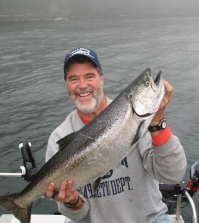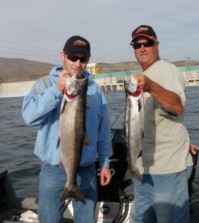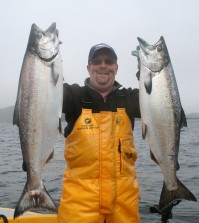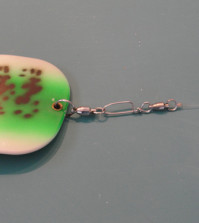Mooch, Jig, or Troll?
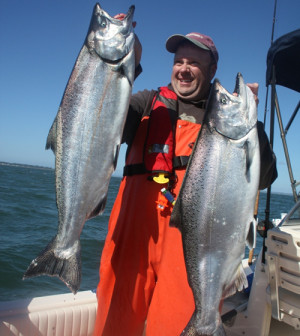
It’s probably safe to say that we all have our favorite salmon fishing techniques. There are those of us who like to troll, those who prefer to yo-yo metal jigs up and down through the water column, and those who aren’t happy unless they’re mooching fresh herring. All these techniques, of course, will catch fish, and for those who have really mastered each of these techniques they will catch fish consistently, but if we get stuck in a rut and stubbornly stick to a fishing method when conditions-and the results–suggest a change in our approach, there are going to be times when we get our butts kicked out there.
Deciding whether to mooch, jig or troll on any given day shouldn’t be left to blind luck, a coin flip or whatever gear you happen to have tied to the end of your line when you wake up in the morning, but on conditions below and above the waters surface that determine what the fish are doing and how you can best present a bait or lure to them most effectively. Some situations allow anglers to catch fish using any of the three techniques, some are suited to only two of the three, and under some extreme conditions you have a decent chance of putting fish in the box with only one of the three basic fishing methods.
Here are what I would consider some of the most important variables to think about when you’re out on the fishing grounds at first light, trying to decide which rod to drag out of the locker and what terminal gear you should be digging out of the tacklebox:
n Salmon density -There’s a pretty good chance that your onboard electronics will provide the first clue as to your best choice of fishing methods. If your ‘sounder” shows a salmon here, the next 15 minutes later and a quarter-mile away, then nothing else for the next half-hour, you’re fishing on widely scattered fish, and trolling is the best way to go find them. Troll with the current or across it to cover as much water as possible and increase your chances of putting a bait or lure in front of a biter.
If, on the other hand, your depthsounder shows fish concentrated in tight schools around bait or near a particular piece of bottom structure, your best bet may be to position yourself over them and work a jig straight down so that you can dance it over, around and through them until one can’t stand it anymore. If you have good electronics and can stay on top of them, you can even watch your jig dancing up and down below you, sort of like playing an electronic fishing game in real time and coming away with scales and fish slime instead of high score. If you can stay atop the concentration of fish, jigging may provide salmon action until your arm falls off!
– Fish depth -The depth at which those fish are holding may also determine which fishing method is most likely to pay off. If, for example, you’re marking blackmouth within 10 feet of the bottom in 100 to 120 feet of water, and your boat isn’t equipped with downriggers, you’re going to have a tough time trolling anything within striking distance. If wind and water conditions are calm, you might want to jig, but if the flow is a little strong, mooching five or six ounces of lead may be the best way to get at ’em. If the fish you’re marking on the ‘sounder are Coho in the top 30 feet of water, though, you can reach them just fine with a sinker or small diver, so trolling will likely keep you in business. If all the fish seem to be in a particularly narrow depth range-whether deep or shallow-downrigger trolling may be just what the doctor ordered, because it will allow you to pinpoint and maintain a specific trolling depth.
– Active/passive -Determining how actively the fish are feeding-or not-usually requires a little trial and error, but if you can figure it out, it may tell you what fishing method is most likely to pay off. Here’s a hint: If you’re marking a lot of fish but the hook-ups are few and far between, chances are you’re on passive fish. They may turn on and start biting anything and everything, of course, but you might get a jump on everyone else by switching from trolling to mooching or jigging until they come to life. Inactive salmon that wouldn’t bother chasing down a trolled bait or lure might be coaxed into taking a fresh herring mooched past their noses at a snail’s pace or a small jig twitched enticingly in front of their noses. During those times when the fish are there but acting tight-lipped, it might also be a good idea to down-size your bait or jig; when they aren’t actively feeding and don’t want a full-meal deal, a little snack just might entice them.
– Current and wind -These variables play a crucial roll in salmon fishing because they affect not only what the fish are doing but also what you and your boat are doing on the surface in relation to the fish below. Vertical jigging, for example, is most effective when you can keep the jig directly beneath you, but strong currents and high winds make that virtually impossible unless you want to use a 12- or 16-ounce jig for salmon. Mooching, on the other hand, can be accomplished with a much wider line angle, so when the tide’s ripping, the wind’s blowing and you can’t hold your position no matter how hard you try, mooching may be a much better bet than jigging. Trolling also may be a productive option when the water’s really moving, as long as you can still maneuver effectively without tangling lines. The troller also has to consider lure speed when he’s fishing during periods of extreme water movement, because it varies greatly depending on whether you’re going with the current, against it, or across it.
– Underwater visibility – Trollers have some advantage over moochers and jiggers when the water’s dirty and the visibility is low. Why? Because they can add flashers, dodgers and other attractors to increase the visibility of their rigs and help draw fish to their baits and lures. Moochers can use brightly colored sinkers and larger baits, while jiggers can go with bigger, gaudier jigs, but none of these offer the far-ranging visibility of a big, reflective Pro-troll flasher or a shiny, twirling Kone Zone that any troller can tie a couple feet up the line. Some of this advantage for trollers may be negated if the cause of the murky water is weeds and moss, which can drape over everything and limit both action and visibility, but trolling still tends to offer better potential under those conditions.
– Other anglers – One of the most apparent-yet still often overlooked-factors in deciding how to fish on any given morning is what everyone around you is doing. It’s almost too obvious to state, but if you’re out there among 50 boats and you’re the only one jigging, odds are you’re wrong and everyone else is right rather than the other way around. Those odds are even greater if you’re the only idiot who isn’t catching anything, so take a hint! Decades of fishing in the Northwest’s many and varied salmon-fishing spots have led to the development of fishing techniques and little adjustments that help anglers catch more fish from those areas, so you can learn from the folks who fish there regularly. Not only are you likely to catch more fish by going with the mob wisdom, but the threats and obscene gestures aimed at you will also drop off considerably.



